Small overlap front: driver-side
Rating applies to 2014-16 models built after January 2014
Tested vehicle: 2014 Mercedes-Benz E 350 4-door
The Mercedes-Benz E-class was redesigned for the 2010 model year. Beginning with 2014 models manufactured after January 2014, the footwell area of the occupant compartment was strengthened to improve occupant protection in small overlap frontal crashes. (Information about when a specific vehicle was manufactured is on the certification label typically affixed to the car on the driver door or adjacent B-pillar.)
| Evaluation criteria | Rating |
|---|---|
| Structure and safety cage | |
| Driver injury measures | |
| Head/neck | |
| Chest | |
| Hip/thigh | |
| Lower leg/foot | |
|
Driver restraints and dummy kinematics
The dummy’s head mostly remained in contact with the frontal airbag, but the head still hit the A-pillar because the seat belt allowed excessive forward excursion of the dummy's head and torso. The side curtain airbag deployed and had sufficient forward coverage to protect the head from contact with side structure and outside objects. | |
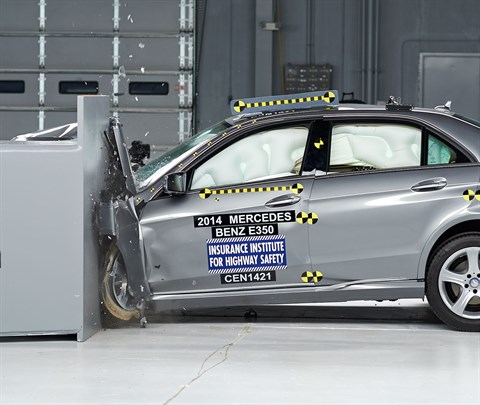
Action shot taken during the small overlap frontal crash test.

The dummy's position in relation to the door frame, steering wheel, and instrument panel after the crash test indicates that the driver's survival space was maintained very well.
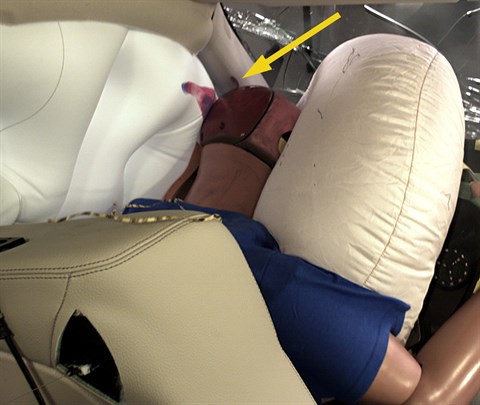
The frontal and side curtain airbags worked reasonably well together, but the seat belt allowed far too much forward movement of the dummy to the extent that its head hit the A-pillar.
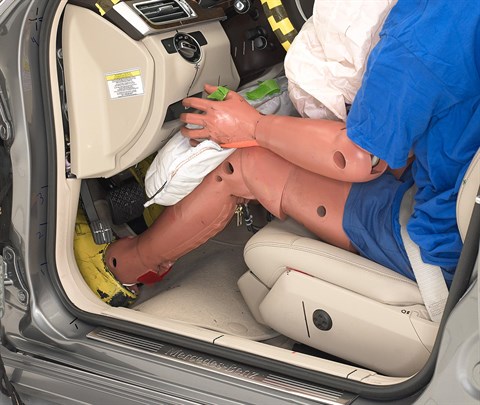
Forces during the crash contributed to a moderate risk of injuries to the dummy's left and right lower legs.
Moderate overlap front: original test
Rating applies to 2010-16 models
Tested vehicle: 2010 Mercedes-Benz E 350 4-door
The Mercedes-Benz E-Class was redesigned for the 2010 model year. Frontal ratings are assigned by the Institute based on a test conducted by Mercedes-Benz.
| Evaluation criteria | Rating |
|---|---|
| Overall evaluation | |
| Structure and safety cage | |
| Driver injury measures | |
| Head/neck | |
| Chest | |
| Leg/foot, left | |
| Leg/foot, right | |
| Driver restraints and dummy kinematics | |
Side: original test
Rating applies to 2010-16 models built after April 2010
Tested vehicle: 2010 Mercedes-Benz E 350 4-door with standard front and rear head curtain airbags and standard front seat-mounted torso airbags
The Mercedes-Benz E-Class was redesigned for the 2010 model year. Beginning with 2010 models built after April 2010, design changes were made to the front and rear door trim to improve occupant protection in side impact crashes. (Information about when a specific vehicle was manufactured is on the certification label typically affixed to the car on the driver door or adjacent B-pillar.)
| Evaluation criteria | Rating |
|---|---|
| Overall evaluation | |
| Structure and safety cage | |
| Driver injury measures | |
| Head/neck | |
| Torso | |
| Pelvis/leg | |
| Driver head protection | |
| Rear passenger injury measures | |
| Head/neck | |
| Torso | |
| Pelvis/leg | |
| Rear passenger head protection | |
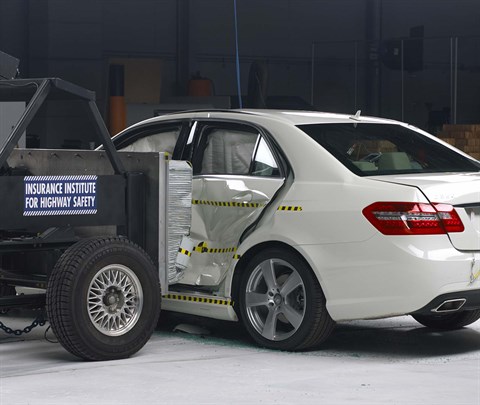
View of the vehicle and barrier just after the crash test.
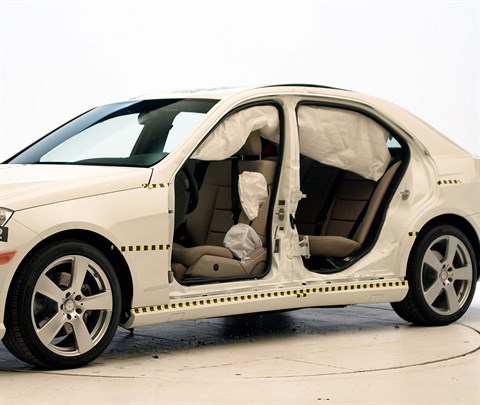
View of the vehicle after the crash with doors removed, showing the side airbags and damage to the occupant compartment.
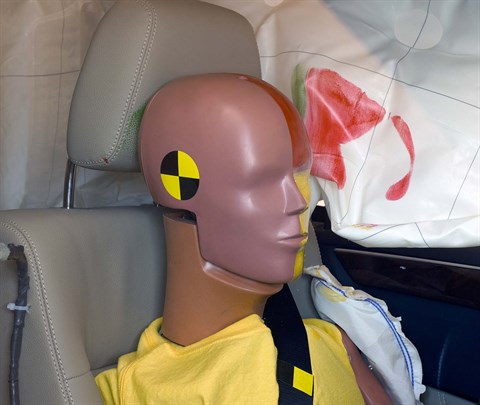
Smeared greasepaint shows where the driver dummy's head was protected from being hit by hard structures by the side airbags.
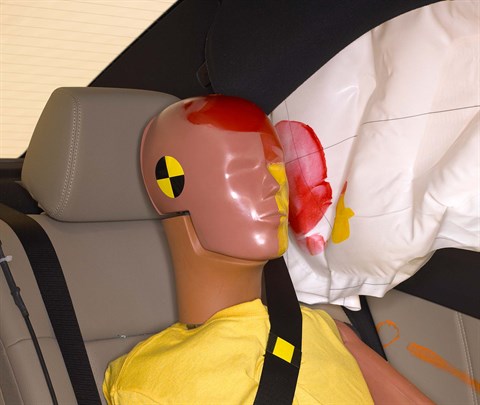
Smeared greasepaint shows where the rear passenger dummy’s head was protected by the side airbag.
Roof strength
Rating applies to 2010-16 models
Tested vehicle: 2010 Mercedes-Benz E 350 4-door
| Overall evaluation | |
|---|---|
| Curb weight | 3,880 lbs |
| Peak force | 20,961 lbs |
| Strength-to-weight ratio | 5.40 |
Head restraints & seats
Seat type: Seats with auto-adjust head restraint AHR
| Overall evaluation | |
|---|---|
| Dynamic rating | |
| Seat/head restraint geometry |
About the head restraint & seat test
Currently, IIHS tests apply only to front seats.
Front crash prevention: vehicle-to-vehicle
Ratings are given for 2 different trim variations available on this vehicle.
Child seat anchors
Rating applies to 2016 models
| Evaluation criteria | Rating |
|---|---|
| Overall evaluation | |
| Vehicle trim | E 400 |
| Seat type | leather |
This vehicle has 2 rear seating positions with complete child seat attachment (LATCH) hardware.
It has 1 additional seating position with a tether anchor only.
| Evaluation criteria | Rating |
|---|---|
| Overall evaluation | |
| Vehicle trim | E 400 |
| Seat type | leather |
| Rating icon | Rating |
|---|---|
| G | Good |
| A | Acceptable |
| M | Marginal |
| P | Poor |
| Seating positions that rely on borrowed lower anchors or have only a tether anchor available are not rated. | |
thether anchor symbol | Tether anchor |
lower anchor symbol | Lower anchors |
| Lower anchor(s) can be borrowed from adjacent positions(s) | |
| No hardware available |
Details by seating position
| Position | Rating |
|---|---|
| 1 | |
| Tether anchor | |
| easy-to-find location | |
| no other hardware could be confused for anchor | |
| Lower anchors | |
| not too deep in seat | |
| not too much force needed to attach | |
| easy to maneuver around anchors | |
| 2 | |
| Tether anchor | |
| easy-to-find location | |
| no other hardware could be confused for anchor | |
| Lower anchors | |
| none available | |
| 3 | |
| Tether anchor | |
| easy-to-find location | |
| no other hardware could be confused for anchor | |
| Lower anchors | |
| not too deep in seat | |
| not too much force needed to attach | |
| easy to maneuver around anchors |
